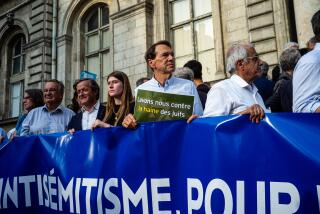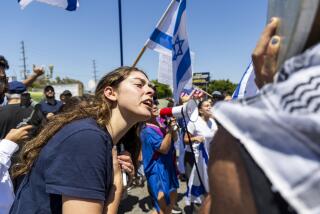Epochal Trip Across Tiber : Pope Visits Synagogue, Assails Anti-Semitism
- Share via
ROME — In the first recorded visit of a Roman Catholic pontiff to a synagogue, Pope John Paul II on Sunday hailed the Jews as “our elder brothers” and condemned “anti-Semitism directed against the Jews at any time and by anyone. I repeat, anyone.”
Traveling the short distance across the Tiber River from the Vatican to Rome’s massive main synagogue, John Paul visited Jews in their place of worship, a symbolic gesture that local leaders of both faiths all called epochal. No Pope since St. Peter had been known to make such a gesture.
Seated in a matching gold and brocade armchair next to Rome’s Chief Rabbi Elio Toaff, John Paul spoke in conciliatory terms against the abuses that the Jewish people have suffered. He expressed “abhorrence” for the Nazi genocide of World War II and deplored centuries of oppression suffered by the Jewish people.
Vatican II Recalled
Although he stopped short of making a plain-spoken apology for the almost 2,000 years of official Roman Catholic sanctions against Jews, the pontiff firmly reiterated the revolutionary decree of the Second Vatican Council, or Vatican II, more than two decades ago. The council, in a landmark decision reversing centuries of Catholic practice, condemned anti-Semitism and formally dismissed the church’s longstanding charge that the Jews were the betrayers, and thus killers, of Jesus.
On Sunday, John Paul noted that that declaration, Nostra Aetate (In Our Times), marked a “decisive turning point” in Christian-Jewish relations and declared that “you are our dearly beloved brothers and, in a certain way, it could be said that you are our elder brothers.”
Enrico Modigliani, one of the Jewish organizers of the Pope’s historic visit to the synagogue, said, “This was an implicit, if not explicit, request for pardon.”
Before the Pope’s visit to the 80-year-old, Assyrian-Babylonian-style building on the Tiber, members of the Rome Jewish community had expressed the hope that he would use the occasion to ask their forgiveness for the countless acts of discrimination and, often, cruelty inflicted on Jews over past centuries.
Until little more than a century ago, the chief rabbi of Rome was annually humiliated by a ritual kick on the backside by the church governor of the city, Jews were confined to a walled ghetto, their social and business lives were severely restricted and individual Jews were made to wear yellow caps for religious identification. Copies of the Talmud were publicly burned and Jews were harassed in virtually everything they did.
But for a time Sunday, the horrors of the past seemed remote. Many of the more than 1,000 people who crowded into the synagogue to hear the Pope and Rabbi Toaff speak and read psalms together had tears in their eyes as they applauded parts of the two religious leaders’ addresses.
“It was a good thing, a beautiful thing,” said Mario Limentani, a 50-year-old Rome businessman who was a prisoner at the Nazis’ Dachau extermination camp during World War II.
“I think now they have finished the persecution of the Jews, and everybody--Jews and Roman Catholics--can be close together,” said Vittorio Astrologio, 64, who also was among the few survivors of the 2,091 Roman Jews deported to Nazi camps during the war.
Limentani, Astrologio and 38 other survivors, mostly of Auschwitz and Dachau, all wearing blue and white scarves, the colors of modern Israel, briskly applauded the Pope when he recalled the suffering of Jews in those years.
Toaff called the Pope’s visit “a gesture destined to pass into history.”
Touchy Question
But in his address to the congregation, broadcast live on Italian state television, the rabbi drew applause when he pointedly raised a subject that the pontiff just as pointedly, and perhaps diplomatically, ignored--the question of Vatican diplomatic recognition of the modern state of Israel.
“The recognition of Israel . . . cannot be denied,” Toaff said. Speaking just a few minutes earlier, the president of the Rome Jewish community, Giacomo Saban, also called for recognition and reminded the Pope that Israel is “central to the heart of every Jew.”
Vatican spokesman Joaquin Navarro Valls had repeatedly warned before the papal visit that John Paul would not discuss such “political” questions at the synagogue. The Vatican has refused to grant official recognition to Israel until the status of Jerusalem as a holy city to three major religions--Christianity, Judaism and Islam--is established.
Near the end of the visit to perhaps the oldest Jewish community in the West, dating back at least 200 years before Christ, John Paul and Rabbi Toaff bowed their heads as a chorus, accompanied by an organist, sang the soaring and grief-ridden “hymn of the camps” that countless thousands of Jews sang as they went to their deaths in Nazi gas chambers.
The hymn, “Ani Maamin” (I Believe), had aroused objections from some Vatican planning officials before the visit because it contains the line, “I believe with all my heart in the coming of the Messiah.” Since Christians believe that the Messiah has already come in the person of Jesus, Vatican prelates found the passage discomforting. But the synagogue planners prevailed in including it in the program.
Matching Chairs
Another minor conflict arose among lower-ranking planners over the two chairs of John Paul and Rabbi Toaff. Vatican planners said that the Pope’s chair, by custom, would be at least slightly larger, even if he was seated next to a head of state, according to a source who preferred to remain unnamed. But the synagogue planners insisted on matching chairs and, again prevailed, although a Vatican clergyman moved them slightly farther apart than the synagogue planners had placed them just before the ceremony.
After each man recited final psalms and stood for a few moments in silent prayer, the Pope embraced the rabbi warmly, to the applause of the congregation, and the two retired for a private visit in Toaff’s study.
They were joined there by Jewish community representatives, including the mother of a 2-year-old boy who was killed in an Arab terrorist attack on the synagogue Oct. 9, 1982, just a few weeks after the Pope received Palestine Liberation Organization Chairman Yasser Arafat in a private audience at the Vatican. Jewish groups hung signs on the synagogue gates after the terrorist attack declaring “Thank You, Pope John Paul,” a bitterly sardonic reference to his reception of Arafat.
Another of the special representatives at the private meeting after the ceremony was Settimia Spizzichinio, the only woman of the World War II Roman Jewish community who survived the Nazi camps. Spizzichinio, now in her mid-60s, said the pontiff’s visit was “very important,” but she added that “much, much more is needed to bring peace and understanding to the world.”
The only immediately visible opposition to the Pope’s visit to the synagogue came from followers of the archconservative Roman Catholic Archbishop Marcel Lefebvre, suspended by Pope Paul VI for opposition to the reforms of the Second Vatican Council. Lefebvre’s followers handed out leaflets Sunday praising the historic church’s condemnation of the Jews and complaining, “Lord, the Pope is changing religion.”
More to Read
Sign up for Essential California
The most important California stories and recommendations in your inbox every morning.
You may occasionally receive promotional content from the Los Angeles Times.










